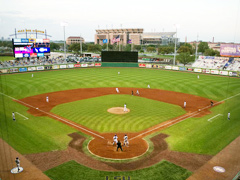Baton Rouge, Louisiana: From Cajun past to Modern Day

Baton Rouge Louisiana conjures images of an elegant southern city with some of the most unique architecture in the country. College sports is a major influence in the city, with their famous Tiger Stadium football games, and the over the top fans for baseball games, the baseball scoreboards are usually alight with color and the fans are incredibly supportive of their teams. While it is the capitol of Louisiana, it has an incredible mixed cultural background and a truly odd reason for the origin of its name.
The area of the country that we know as Baton Rouge was actually inhabited as far back as 8,000 B.C. with a hunter gatherer tribe. Its location was discovered in 1699 by a French Explorer, when he came across a series of poles planted in the ground and strung with bloody animals. These were the markers for the territories of the local tribes. He coined the name ‘baton rouge’, which means red batons or poles.
By around 1719, a military post was set up by the French at Baton Rouge and due to its location; it became a port for transportation of supplies. Over the years, the settlement has been governed and claimed by the Spanish, French, English, the even the Republic of Florida and the Confederate States. When some of the maritime residents of Canada were exiled they traveled and eventually settled in Baton Rouge. They were called ‘cajuns’ and brought their unique culture that has continued to influence the State of Louisiana today.
It wasn’t until 1817 that Baton Rouge was announced as the state capitol. It was common for architects to design a capitol building that emulated Washington, D.C… Maintaining their difference, it was decided to build a state capitol building in Baton Rouge that incorporated a medieval, neo-gothic style that included all of the accoutrements: stained glass, crenellations and even turrets. This set the area of Baton Rouge apart from any other state at that time.
The Civil War caused the Union Troops to occupy Baton Rouge and it wasn’t until 1882 that everything settled down and the city was returned as the state capitol. The growth of the area was slow. By the 1950-1960’s the petrochemical industry established corporate offices and investments in the area, which created a population explosion of jobs and growth. Architecture of the latest design was set next to historical buildings and monuments. While the area continued to expand with rapid progress, it experienced an unprecedented explosion with an influx of people escaping the devastation of Hurricane Katrina.
The people of Baton Rouge take incredible pride in their diverse history and culture. The expansion of the area always included relating the story of their history. Museums and centers for the arts and theatre are sprinkled throughout the city. Visitors can take a tour through Spanish Town, which reflects another aspect of the city’s past. They celebrate their rich history with many complimentary Mardi Gras parades. The neo-gothic building style is style represented and many of the old southern plantations are in wonderful condition to view a slice of history.
Education is paramount in the state, with many schools of excellence in both standard levels as well as university level. College sports are a major focus in the Baton Rouge area. Baseball, football, rugby and soccer games are attended with record breaking crowds. College football is specifically popular and it’s not uncommon to see the entire town decked out in the team colors. The baseball scoreboards are always lit and also flagged with the colors of the game.
A visitor to Baton Rouge will have the opportunity to experience the true sense of the state of Louisiana; complete with wonderful cuisine, cultural views and lifestyles. Louisiana is a place like no other and Baton Rouge represents some of the best of the state.


